What is turnip, what does it look like, how does it grow and how to eat it correctly?
Today, not every person knows anything about turnips. However, thanks to its rich composition, the vegetable has a lot of beneficial properties. Its regular consumption has a beneficial effect on the health of children and adults. From the article you will learn what it is - turnips, about its benefits, dangers and rules for growing in open ground.
What kind of plant is turnip?
Turnip (fodder turnip) is a biennial plant belonging to the cruciferous (cabbage) family. Initially, the vegetable was grown to feed livestock; later, breeders developed root crops with excellent taste, suitable for human consumption. There are about 10 varieties with juicy pulp and various gastronomic notes.
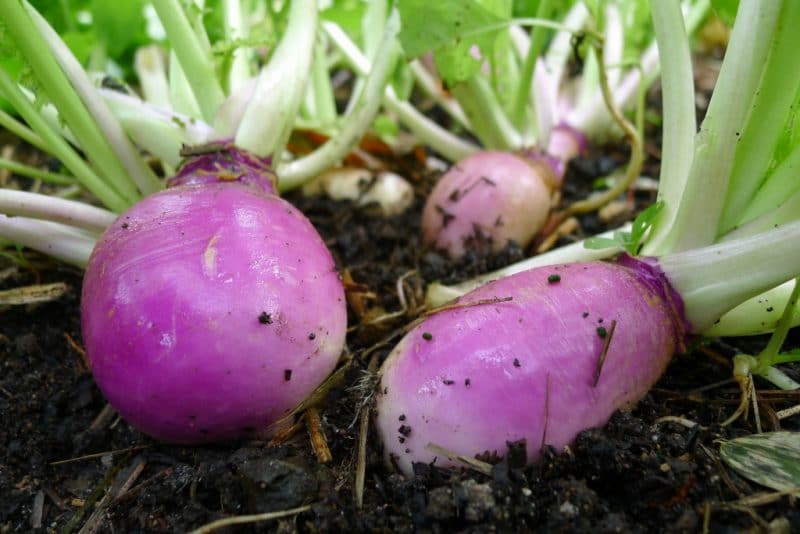
What does it look like
Sometimes turnips are confused with rutabaga, its close relative. However, these 2 vegetables have differences: rutabaga has darker flesh, it is larger in size and is absolutely not bitter, with a sweet taste.
The features of fodder turnips are as follows:
- root length reaches 150 cm, width – 50 cm;
- The root crop is characterized by a cone-shaped or oval shape;
- the oval, slightly elongated leaves are colored light green, and the tops are green, sometimes with a purple tint;
- The root vegetable can be white, green, yellow, purple or orange, and its flesh can be yellow or white.
The photo shows that the characteristic difference between turnips and other cruciferous vegetables is the pubescence of the leaves, but some varieties have a smooth surface.
Taste and aroma
The taste of the vegetable is determined by its variety: the pungency of the vegetable is reminiscent of radishes, table root vegetables are much sweeter, juicier and are a cross between potatoes and carrots. The table version has a spicy aroma.
In addition to root vegetables, the tops are also edible: the leaves, which have a mustard taste, are suitable for consumption both after cooking and fresh.
Where does it grow?
Due to its unpretentiousness and unusual taste, turnips have become popular in many countries around the world. It is especially actively grown in Australia, Germany, Great Britain, Canada, Denmark, the USA, etc. Large areas of cultivation are found in places with sufficient moisture and sunlight, where the temperature in summer does not fall below +6°C.
What's good about turnips?
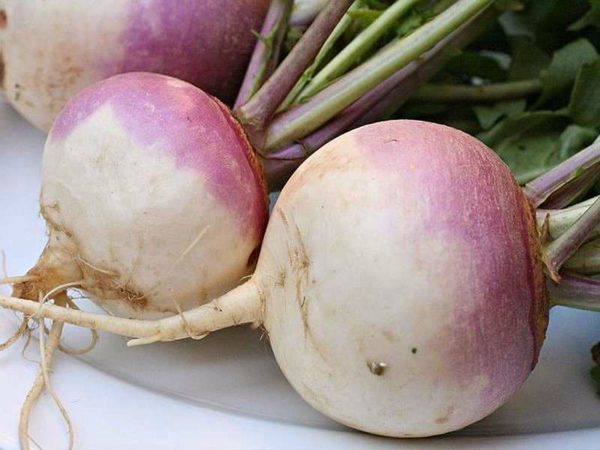
Low-calorie turnip is an ideal food for people who adhere to proper nutrition and strictly monitor their health. The vegetable contains many useful substances and vitamins that have a beneficial effect on the functioning of the body.
Composition, properties, KBJU
Nutritional value of turnip (per 100 g):
- calorie content – 28 kcal;
- carbohydrates – 4.6 g;
- proteins – 0.9 g;
- dietary fiber – 1.8 g;
- fats – 0.1 g;
- water – 92 g.
The vegetable also includes:
- vitamins A, C, E, K, group B;
- phosphorus;
- manganese;
- magnesium;
- calcium;
- iron;
- zinc;
- cellulose;
- organic acids;
- flavonoids.
Turnips have a number of useful properties:
- increased appetite;
- regulation of blood sugar levels;
- strengthening blood vessels;
- blood thinning;
- strengthening the nervous and immune systems.
The root vegetable has anti-inflammatory and bactericidal properties.
This is interesting:
When to harvest cabbage from the garden for storage for the winter according to the lunar calendar
How and with what to eat turnips, and what does it taste and smell like?
How to properly prepare dried horseradish, store it and use it
Useful properties and contraindications
Regular consumption of the crop brings significant benefits to the body:
- The presence of vitamin C in vegetables creates reliable protection against the negative effects of ultraviolet radiation, maintains visual acuity, and also reduces the likelihood of macular degeneration.
- Due to the high fiber content, the risk of exacerbations of diverticulitis is reduced.
- Vitamin B contained in turnips ensures hormonal stability and normalizes the functioning of all body systems.
- The components of the vegetable neutralize the effects of free radicals and reduce the risk of developing malignant tumors.
- Dietary fiber successfully eliminates many gastrointestinal problems: diarrhea, bloating, constipation and cramps.
- Calcium restores bone tissue.
- Potassium reduces the load on arteries and blood vessels, preventing the development of many heart diseases.
Due to the likelihood of increased gas formation, it is not recommended to abuse turnips for people suffering from gastrointestinal diseases. It is contraindicated for diseases of the pancreas and thyroid glands, impaired liver function and individual intolerance.
Varieties
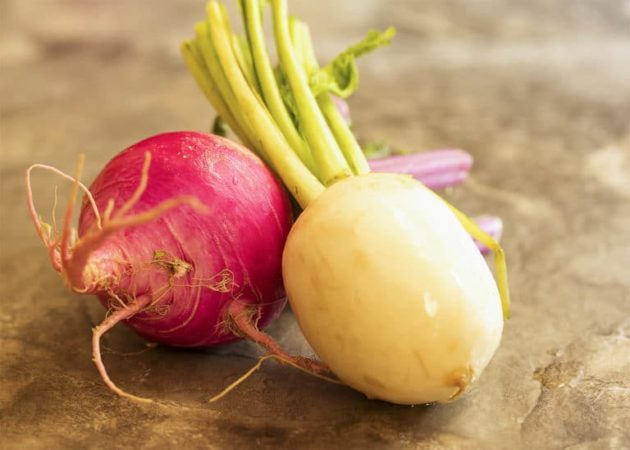
There are 2 types of turnips: with yellow and white flesh.
The most common yellow meat varieties:
- Bortfelsky;
- Yellow violet-headed;
- Grayson;
- Yello-tankard.
Popular white meat varieties:
- Osterzundomsky;
- Norfolk;
- White ball;
- Mancunian;
- Six weeks.
The following varieties are most often found in Russia:
- Moscow;
- Violet;
- Snowball;
- Amber ball;
- Orange jelly;
- Japanese.
Outdoor cultivation technology
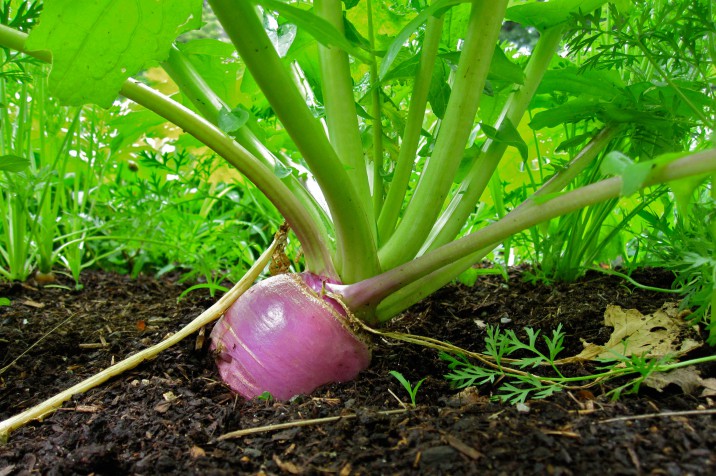
In the first year, turnips develop a root crop and a rosette of leaves, in the second - inflorescences and seeds. The vegetable crop is unpretentious, grows quickly and produces high yields. However, when cultivating turnips, it is worth considering its intolerance to excessive heat and drought.
Important! Before the root crop forms, the plant can easily withstand temperatures down to -8°C.
Planting, care, protection from diseases and pests
Sowing turnips is carried out taking into account several rules:
- using a two-line method, in which the distance between rows is 50 cm;
- thinning out too dense seedlings after they have formed 3 full leaves;
- maintaining an interval between shoots of 20 cm.
Seedlings are planted in open ground in the second half of May, and in the northern regions - after the warm weather becomes stable. For planting, choose a sunny place in the lowlands, where direct sunlight does not reach.
Rules for growing and caring for outdoors:
- Form holes 6 cm deep.
- First, the roots are placed in a clay mash, and then the plant is lowered into the prepared hole.
- Sprinkle with soil, compact and moisten.
- Provide shade for plantings.
- Due to a lack of moisture, root vegetables acquire a bitter taste, and due to an excess, they become watery. The correct water consumption is for young specimens – 6 l/m², for fully formed plants – 4 l/m². The recommended frequency of watering is 2 times a week, regardless of weather conditions.
- After moistening, loosen the soil to a depth of 8 cm and at the same time remove weeds.
- Twice a season, organic fertilizers prepared from slurry or chicken droppings are applied. To increase sugar content in June – July, vegetable crops are fed with superphosphate.
During the growing process, vegetable crops may be affected by the following diseases:
- clubroot;
- mosaic;
- blackleg;
- vascular bacteriosis.
Fungicides are used for preventive and therapeutic purposes.
The plant is often attacked by pests, such as:
- cabbage fly;
- cruciferous flea beetle;
- bedbugs;
- aphid.
To combat these insects, planting beds are treated with insecticides.
Harvesting and storage
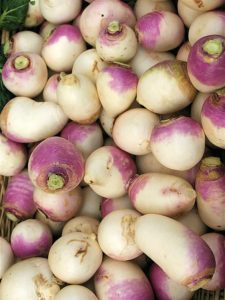
Depending on the varietal characteristics, the ripening period of turnips ranges from 45 to 90 days. The yellowing lower leaves of the crop indicate that it is time for harvesting.
Harvesting is carried out on a dry and sunny day, this process includes several steps:
- extracting root crops from the soil;
- removal of remaining soil;
- trimming the tops (this leaves a small stump);
- dry in a well-ventilated place.
Only whole root vegetables without the slightest damage are left for storage. For a high degree of shelf life of the crop, it is important to create the following conditions:
- air temperature – from +3°С to -2°С;
- humidity level – 85-90%;
- availability of high-quality ventilation.
When properly stored, root vegetables retain their original quality for up to 1 year.
How to choose the right turnips in the store
When purchasing vegetables, you should adhere to the following recommendations:
- give preference to specimens with smooth skin without any damage or stains;
- pay attention to the weight - a ripe root vegetable turns out to be heavier than it looks at first glance.
How to eat it: the best recipes with turnips
A high-quality product is crunchy, juicy, has a sweetish taste and lacks bitterness. These products make excellent snacks, side dishes, cold soups, as well as stewed, stuffed and baked dishes.
There are many options for preparing this vegetable, all of them are quite simple and even inexperienced cooks can do.
Casserole with onions and cheese

Components:
- 4 root vegetables;
- 4 onions;
- 100 ml chicken broth;
- 2 tbsp. grated cheese;
- 4 tbsp. l. butter;
- 100 ml cream;
- greens, hot pepper and salt - to taste.
Preparation:
- Wash the turnips, peel them and cut them thinly.
- Grind the cheese on a coarse grater.
- Cut the onion into half rings.
- Melt the butter in a frying pan and add layers of root vegetables, onions and cheese.
- Mix the broth with cream and pour into the pan.
- Salt and pepper the dish.
- Alternate layers in a similar manner until the components run out.
- Preheat the oven to 180°C and place the casserole in it for about 20 minutes.
Before serving, sprinkle the dish with fresh herbs.
Vegetarian soup
Ingredients:
- ½ kg potatoes;
- 2 carrots;
- ½ kg of root vegetables;
- 2 leeks;
- 150 g pearl barley;
- 1 onion;
- several peas of black and allspice;
- parsley, bay leaf and salt - to taste.
Preparation:
- Cut the turnips and potatoes into small cubes and place them together with pearl barley in boiling water.
- Chop the leek into slices, onion and carrot into small cubes.
- Sauté vegetables in vegetable oil, combine with the rest of the ingredients and cook until tender.
- 5 minutes before the end of cooking, add chopped parsley, bay leaf and peppercorns to the pan.
Salad with Chinese cabbage
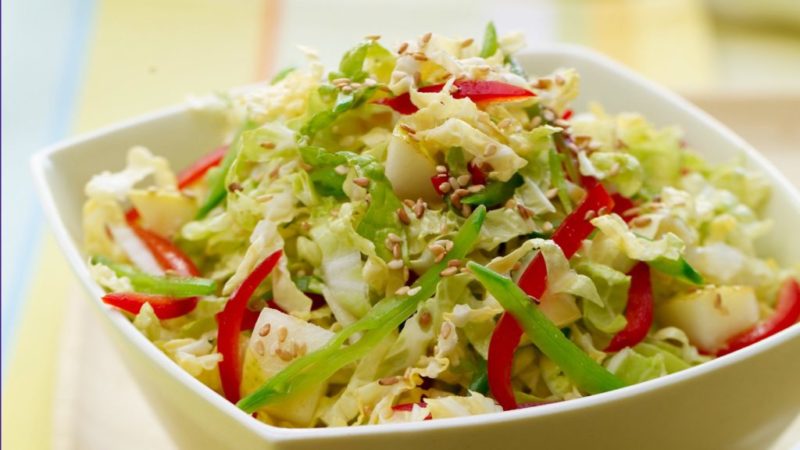
Components:
- 300 g turnip;
- fresh herbs: parsley, onion and dill;
- 1 Chinese cabbage;
- 2 eggs;
- 3 tbsp. l. sour cream;
- 1 tbsp. l. sunflower oil (refined);
- ground black pepper and salt - to taste;
- ½ lemon.
Preparation:
- Squeeze juice from lemon.
- Boil hard-boiled eggs.
- Cut the washed and peeled turnips into thin strips, add salt and pepper and set aside for a while so that the vegetable releases its juice.
- Chop cabbage and greens.
- Grind the eggs.
- Prepare the sauce by mixing lemon juice with sour cream and vegetable oil.
- Place the ingredients in a salad bowl in the following order: turnip mixed with herbs, eggs, sauce.
It is recommended to serve the dish approximately 1-2 hours after cooking, so that it has time to soak.
Turnip stew
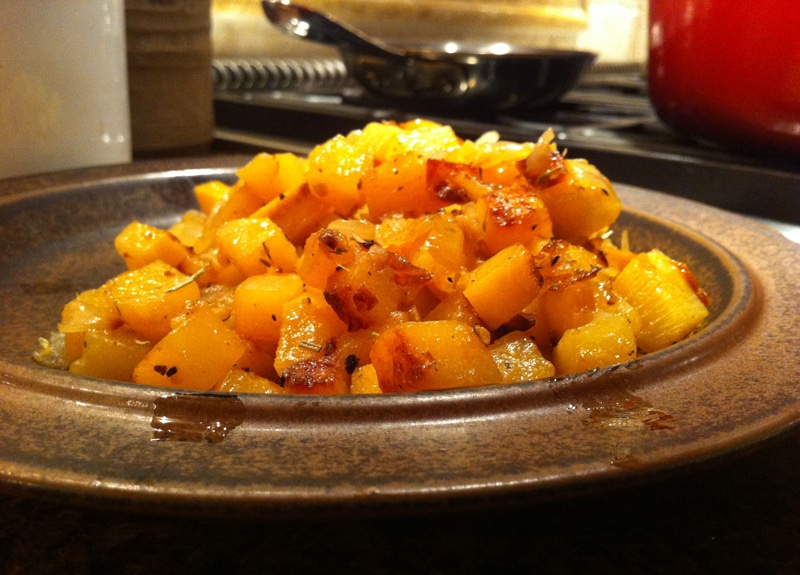
Ingredients:
- 1 kg of root vegetables;
- 1 tbsp. l. Sahara;
- 100 g butter;
- 200 g broth;
- black pepper, salt - to taste.
Preparation:
- Cut the turnips into small slices.
- Melt butter and sugar until brown.
- Pour the root vegetable into a pan with oil, add a small amount of water and simmer until fully cooked.
- A few minutes before the end of the process, add sour cream, pepper and salt.
The dish is served separately or as a side dish with boiled potatoes and meat.
Conclusion
Turnips are a vegetable enriched with many nutrients that are beneficial for health. There are many recipes that allow you to prepare delicious and nutritious dishes from root vegetables and young tops.